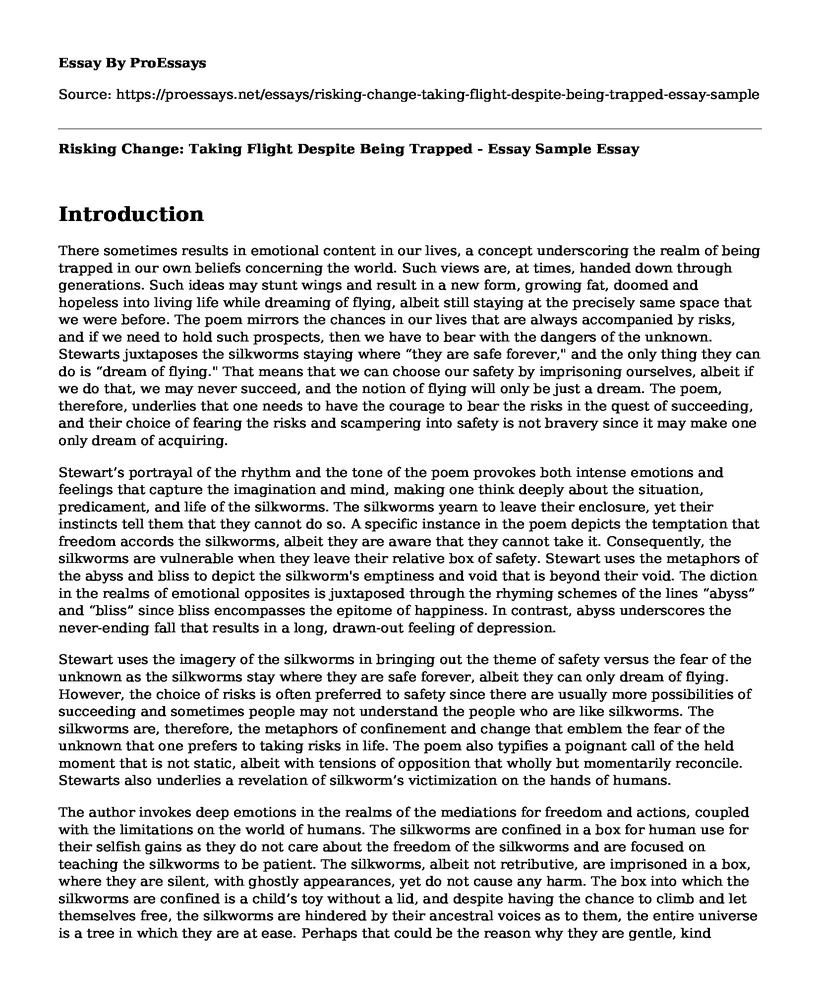Introduction
There sometimes results in emotional content in our lives, a concept underscoring the realm of being trapped in our own beliefs concerning the world. Such views are, at times, handed down through generations. Such ideas may stunt wings and result in a new form, growing fat, doomed and hopeless into living life while dreaming of flying, albeit still staying at the precisely same space that we were before. The poem mirrors the chances in our lives that are always accompanied by risks, and if we need to hold such prospects, then we have to bear with the dangers of the unknown. Stewarts juxtaposes the silkworms staying where “they are safe forever," and the only thing they can do is “dream of flying." That means that we can choose our safety by imprisoning ourselves, albeit if we do that, we may never succeed, and the notion of flying will only be just a dream. The poem, therefore, underlies that one needs to have the courage to bear the risks in the quest of succeeding, and their choice of fearing the risks and scampering into safety is not bravery since it may make one only dream of acquiring.
Stewart’s portrayal of the rhythm and the tone of the poem provokes both intense emotions and feelings that capture the imagination and mind, making one think deeply about the situation, predicament, and life of the silkworms. The silkworms yearn to leave their enclosure, yet their instincts tell them that they cannot do so. A specific instance in the poem depicts the temptation that freedom accords the silkworms, albeit they are aware that they cannot take it. Consequently, the silkworms are vulnerable when they leave their relative box of safety. Stewart uses the metaphors of the abyss and bliss to depict the silkworm's emptiness and void that is beyond their void. The diction in the realms of emotional opposites is juxtaposed through the rhyming schemes of the lines “abyss” and “bliss” since bliss encompasses the epitome of happiness. In contrast, abyss underscores the never-ending fall that results in a long, drawn-out feeling of depression.
Stewart uses the imagery of the silkworms in bringing out the theme of safety versus the fear of the unknown as the silkworms stay where they are safe forever, albeit they can only dream of flying. However, the choice of risks is often preferred to safety since there are usually more possibilities of succeeding and sometimes people may not understand the people who are like silkworms. The silkworms are, therefore, the metaphors of confinement and change that emblem the fear of the unknown that one prefers to taking risks in life. The poem also typifies a poignant call of the held moment that is not static, albeit with tensions of opposition that wholly but momentarily reconcile. Stewarts also underlies a revelation of silkworm’s victimization on the hands of humans.
The author invokes deep emotions in the realms of the mediations for freedom and actions, coupled with the limitations on the world of humans. The silkworms are confined in a box for human use for their selfish gains as they do not care about the freedom of the silkworms and are focused on teaching the silkworms to be patient. The silkworms, albeit not retributive, are imprisoned in a box, where they are silent, with ghostly appearances, yet do not cause any harm. The box into which the silkworms are confined is a child’s toy without a lid, and despite having the chance to climb and let themselves free, the silkworms are hindered by their ancestral voices as to them, the entire universe is a tree in which they are at ease. Perhaps that could be the reason why they are gentle, kind together and love each other, and at times dream of flying. By that, Stewart presents the sympathy of the Silkworms’ hard labor like the slaves.
The poem underscores the use of both ghost rhymes and half-rhymes in reinforcing the atmosphere of movement, coupled with gentle frustration, typified by the delicate gravity of the tone used together with the unassertive limits of human existence acceptance. The poem, therefore, is a mediation of on the whole condition of humans in the realms of how life is fashioned ordered, shaped and restricted by conventions inhibitions that have been made stable by limitations, making it a poem of a continuous life process.
Cite this page
Risking Change: Taking Flight Despite Being Trapped - Essay Sample. (2023, Aug 26). Retrieved from https://proessays.net/essays/risking-change-taking-flight-despite-being-trapped-essay-sample
If you are the original author of this essay and no longer wish to have it published on the ProEssays website, please click below to request its removal:
- A Literary Essay sample. Ray Bradbury's There Will Come Soft Rains
- Literary Devices: Diction, Sonnet and Imagery Essay
- Critical Essay on Similarities between Antigone in "Antigone" and Nora in "A Doll's House"
- Suffering Breeds in Wisdom: King Lear Essay
- Literary Analysis Essay on Roles of Women in Frankenstein
- Essay Example on Foreshadowing in Steinbeck's 'Of Mice and Men'
- Everyday Use: Exploring Materialism & Family Cohesion Through Culture - Essay Sample







